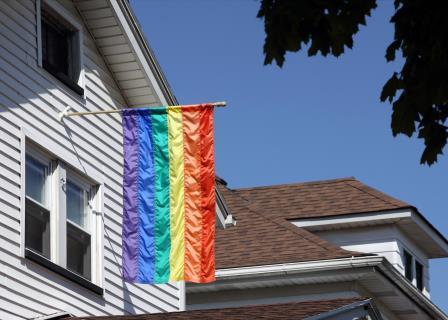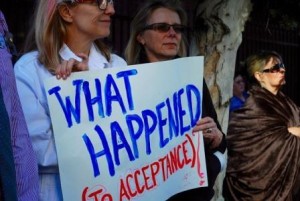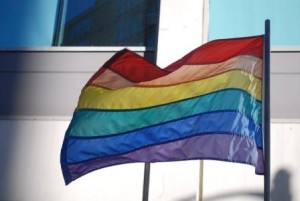- Calls to this hotline are currently being directed to Within Health, Fay or Eating Disorder Solutions
- Representatives are standing by 24/7 to help answer your questions
- All calls are confidential and HIPAA compliant
- There is no obligation or cost to call
- Eating Disorder Hope does not receive any commissions or fees dependent upon which provider you select
- Additional treatment providers are located on our directory or samhsa.gov
The Transgender Look: Body Image, Identity and Eating Disorders within the Community

Contributed by Staff Writer for Eating Disorder Hope.
The concept of body image is such a vast topic: one might well write a book on the topic, indeed many have published such books. Historically, women in North American and western cultures have been stereotyped as being the victims of a media-focused culture, one that creates dissatisfaction with looks and suggests that unrealistic physical achievements are the norm.
The age-old reference of dolls with thin waists and large plastic chests come to mind, we know that the proportions on such dolls are not accurate nor realistic. This appears to encourage the idea that women in Western cultures have unachievable beauty standards, with a physical focus and generally ignoring all the other things that create one’s identity: spirituality, intelligence, emotional intelligence, hobbies etc.
So, it is easy to see how women might generally be considered to have issues with identity, after all, perceiving oneself as valuable only appearance and sexualisation is degrading, helping perpetuate feelings of worthlessness, failure, and disempowerment.
Self-identity refer to one’s self-image, who you are in the world, community, family, strengths, weakness, goals, successes – and many more. Essentially, who you are and where you fit in the world comprises pieces of identity. Like women held to an unattainable physical ideal, so are homosexual men and women and transgender individuals.
Body Image and Societal Expectations
Especially consider the lesbian, gay, bisexual, transgender, questioning and queer (LGBTQQ) communities and think about the labels that have been placed on them at times – each ‘label’ may hold an automatic stereotype in our minds, some of these might be less than flattering.
For a marginalized group, consolidating such a stereotype against one’s identity can be challenging and often individuals experience feelings of dissonance with who they perceive themselves to be and who they want to be. Clearly, body image has a connection with some of these societal norms and expectations.
 For transgender individuals, identity issues may present even more of a challenge. gender identity and gender expression usually conform to anatomic and chromosomal sex (or “natal” sex), meaning that gender identity is knowledge of one’s anatomic sex, while gender expression if the outward expression of gender [3].
For transgender individuals, identity issues may present even more of a challenge. gender identity and gender expression usually conform to anatomic and chromosomal sex (or “natal” sex), meaning that gender identity is knowledge of one’s anatomic sex, while gender expression if the outward expression of gender [3].
Arguably, members of the transgender community face even more vast disparities between their appearance and perceived ideal, contributing to issues with identity [3]. After all, for transgender individuals, gender expression does not match natal sex and are considered gender nonconforming [3].
Some individuals naturally experience gender dysphoria, a feeling of dissatisfaction with gender expression, as children. However, for those whose natal sex does not match gender expression, it is difficult to predict who will experience gender dysphoria [3].
Considering that eating disorders are linked to the identity issues that often appear alongside body image issues, it is unsurprising then to learn that eating disorders can appear prevalent within groups struggling to determine their self-identity.
Returning to the idea of body image, literature tells us that 1 in 3 men engage in disordered eating pattern while 91%of women attempt to control weight through restrictive dieting [1]. In fact, the studies reveal that it is rare to find individuals whose body image concerns are not connected to identity struggles and identity development [1].
Research is Needed
When considering the transgender community, very little research exists specifically focusing on disordered eating behaviours, the transgender community and weight-disparity. In fact, what literature agrees upon that despite being considered a “national health priority within Healthy People 2020” (p. 2), the literature around the subject just is not there [2].
For instance, a recent study found that out of over 13,000 subjects, only 53 identified as transgender, and were less likely to identify as white when compared to non-transgender subjects, and more likely to be underweight or overweight than normal weight [2].
 It is apparent that within the transgender group, disparities between weight and exercise exist when compared to non-transgender populations. Previous literature has suggested that transgender individuals have higher dissatisfaction with their bodies, which is in line with the results of the more recent study [2].
It is apparent that within the transgender group, disparities between weight and exercise exist when compared to non-transgender populations. Previous literature has suggested that transgender individuals have higher dissatisfaction with their bodies, which is in line with the results of the more recent study [2].
Despite the lack of research and quantitative studies examining transgender communities, identity and disordered eating, some case studies and preliminary research point to an association. Interestingly, in 2013 when the DSM-5 was published, Gender Identity Disorder (GID) was removed from the DSM – likely in an effort to cease pathologizing the identity issues of transgender people [4].
However, prior to this, case studies described patients with concurrent GID and eating disorders, while one study pointed out that male transitioning to female participants recorded higher levels of disordered eating than both male and female controls – a significant finding [4]! Further, natal female women with GID experienced more disordered eating patterns than controls [4].
Interestingly, some research found that gender reassignment had a mix of positive and negative outcomes upon body image, with improvements in body image being linked to a reduction in disordered eating symptoms [4].
For instance, one female transitioning to male reported no longer fearing an appearance of femininity if she gained weight, after starting hormone therapy. A male transitioning to female reported that gender reassignment surgery gave her more confidence in herself [4].
 Clearly, members of the transgender community are at a higher risk for developing eating disorders or engaging in disordered eating for a variety of reason, including: societal norms, body image, identity issues, perceived control, to regain control, feeling undeserving of nourishment. In fact, some purported causes include a desire to suppress or accentuate gender, and as a result of positive or negative change [4].
Clearly, members of the transgender community are at a higher risk for developing eating disorders or engaging in disordered eating for a variety of reason, including: societal norms, body image, identity issues, perceived control, to regain control, feeling undeserving of nourishment. In fact, some purported causes include a desire to suppress or accentuate gender, and as a result of positive or negative change [4].
Some limitations to current research includes using the blanket term “transgender”, we know that transgender people may be heterosexual, homosexual or bisexual, they may identify by natal gender and be transitioning to desired gender, and may or may not alter their bodies to match their perceived gender [3].
Utilizing the term “transgender” certainly allows for us to describe a large group of people succinctly, but does nothing to allow for individual differences within a group of vastly different people.
These results have vast implications for considering eating disorder treatment for the transgender communities, after all, it appears that disordered eating has an association with identity and body image issues. For researchers, we know that in the world of academia more work needs to be done examining the prevalence of eating disorders and other psychopathology within the transgender community.
For professionals, it is important practice from a culturally informed place, gaining knowledge around the LGBTQQ community, transgender specific issues, and pursuing additional training in identity issues and treatment for eating disorders.
References:
[1]: Chabot, N. (2015). How to Look the Part: Implications of Body Image Issues for Lesbian, Gay, and Bisexual College Students. The Vermont Connection, 26 (1), 8.[2]: VanKim, N. A., Erickson, D. J., Eisenberg, M. E., Lust, K., Rosser, B. S., & Laska, M. N. (2014). Weight-related disparities for transgender college students. Health behavior and policy review, 1(2), 161.
[3]: Levine, D. A., Braverman, P. K., Adelman, W. P., Breuner, C. C., Marcell, A. V., Murray, P. J., & O’Brien, R. F. (2013). Office-based care for lesbian, gay, bisexual, transgender, and questioning youth. Pediatrics, 132(1), e297-e313.
[4]: Ålgars, M. K. (2012). Disordered Eating and Gender Identity Disorder: A Qualitative Study. Eating Disorders, 20(4), 300-311.
The opinions and views of our guest contributors are shared to provide a broad perspective of eating disorders. These are not necessarily the views of Eating Disorder Hope, but an effort to offer discussion of various issues by different concerned individuals.
We at Eating Disorder Hope understand that eating disorders result from a combination of environmental and genetic factors. If you or a loved one are suffering from an eating disorder, please know that there is hope for you, and seek immediate professional help.
Last Updated & Reviewed By: Jacquelyn Ekern, MS, LPC on April 13, 2016
Published on EatingDisorderHope.com

The EatingDisorderHope.com editorial team comprises experienced writers, editors, and medical reviewers specializing in eating disorders, treatment, and mental and behavioral health.

